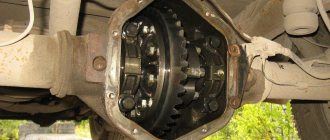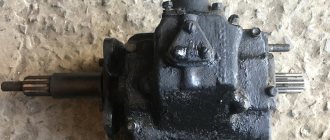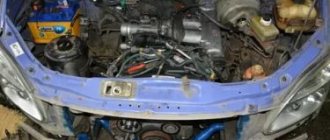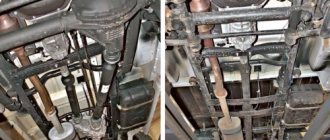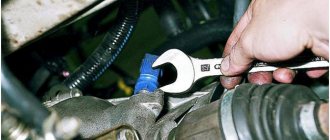Autumn, damp weather, my selector position sensor began to act up. You start the car, drive out - everything is fine. And then, like crazy, it jumps from “D” to “N”, “Check” lights up.
Today I’ll tell you how I solved this problem. But first you need to find out what the automatic transmission selector position sensor is and how it works.
Automatic transmission selector position sensor
The machine contains several types of devices that monitor the parameters of the gearbox so that deviations do not occur. When any part breaks or the device fails, it sends a signal to the control panel monitor.
Automatic transmission sensors:
- device for determining speed. Determines the rotation speed of the input and output shafts;
- lubricant pressure and automatic transmission temperature sensors;
- ECU. The electronic control unit is the brain of the vehicle system;
- and, finally, the automatic transmission inhibitor we need or the selector position sensor.
The position sensor consists of resistive plates and a slider that moves.
Attention! The automatic transmission selector position device is a sealed device, which is better not to disassemble, but to replace completely. Since disassembly and reassembly can lead to subsequent system failures. And a hacked inhibitor is difficult to configure to function adequately.
Operating principle of the sensor
The operating principle of the sensor is as follows:
Read
Why Suprotec is the best solution for automatic transmission restoration
- You change the position of the selector lever.
- The position taken by the curtain is recorded in an electronic device. At the same second, it transmits this data to the electronic control unit of the machine.
- The program is launched in the on-board computer.
- According to the given signal, the hydraulic system begins to work. The necessary valves open, the brake band clamps the friction discs, and the desired gear is engaged.
This is how the gear selector position device works. But in addition to its main function, it is responsible for some components of the car. More on this in the next block.
What is the sensor responsible for?
The selector lever position sensor is a multifunctional device. The signal from it turns on the reversing lamps. The inhibitor controls the operation of the starter drive in the “P” and “N” positions. That is why the serviceability of the device is important.
The driving mode is determined using a potentiometer. The resistance of the device depends on the position of the slider. At the same time, the output voltage also changes. And the voltage directly works with the valve body valves, opening or closing them.
Where is it located?
It can be found on the device selector shaft. In most cases it is connected to the spool valve actuator in the hydraulic plate.
Attention! The sensor is opened by drilling out rivets.
Now you know what the device is and how to find it. Next, I will talk about common causes of device malfunctions and point out signs of failure.
In the meantime, write in the comments whether you have already disassembled the automatic transmission selector position sensor or replaced it?
Strict necessity
The automatic transmission is designed in such a way that almost all manipulations in it occur with the help of oil injected under pressure. The pressure is pumped up by a special oil pump, which in its structure and design resembles an engine cooling pump and works in a similar way.
The oil circulates at incredible speed. To at least roughly imagine what this speed is, you need to open a water tap and in your imagination increase the pressure and pressure of this water several tens of times.
An inexperienced motorist, and indeed a person who does not repair automatic transmissions on his own, will have a logical question: why is such high pressure needed, and why is it so useful when operating an automatic transmission?
In fact, all movements of the clutches, which are similar in principle to the gear shafts of mechanical transmissions, are carried out precisely due to a powerful jet of oil. This oil flows through a system of automatically shutting channels called solenoids. Depending on the path for oil provided by the solenoid, the clutches move under pressure in such a way that they eventually form packages that connect the engine and wheels in a certain way.
When an automatic transmission is operating, the oil inevitably heats up: this is caused simultaneously by high pressure in the oil channels and strong friction achieved when connecting the clutches and their synchronous movement. The temperature sensor allows the automatic transmission control unit to receive data about the state of the technical fluid in the crankcase and how efficient the entire functional unit is.
Causes of malfunctions
Failure of the gear selector position device can be caused by simple high humidity. That's how it happened for me.
Read
All about the Jatco JF414E automatic transmission installed on the Lada Granta, as well as reviews
After I opened this device with a screwdriver, I found oxidized contacts, dirty internal surfaces and dried grease. There was no point in repairing it for me, so I replaced it with a new one.
Moisture enters due to loss of tightness. To prevent water from getting in, it is necessary to install the crankcase on the bottom of the car, which protects the selector shaft, automatic transmission ECU and engine from dust, water and dirt. It also protects these devices from impacts that may occur while driving on uneven dirt roads.
In addition to water, a malfunction can occur due to contact abrasion. Erasing occurs if there is constant operation of the selector lever, especially in traffic jams.
A short circuit can also cause the device to fail. Incorrect adjustment of the selector lever, damage to the gearbox valve body are also causes of device malfunctions.
Gear shift detection
The device monitors the position of the automatic transmission lever. On most cars, the sensor is located directly next to the selector lever. In rare cases, a cable leads to it.
The reasons for node failure are:
- moisture entering the housing;
- loss of tightness;
- mechanical wear of contact lamellas;
- physical damage to the device under external influence;
- contamination or oxidation of the contact group.
If it is impossible to determine the position of the selector, the “HOLD” light comes on. Sometimes, after repeatedly moving the lever, it is possible to start moving. The failure of the device occurs gradually.
Signs of breakdown
The vehicle may be completely immobilized as a result of sensor failure. Since it stops receiving data from the components associated with it, in order not to cause harm, the automation turns off all electronics. But this rarely happens.
Most often, if the automatic transmission selector position device breaks down, the following error information appears on the panel screen:
- "Check Engine". This type of error may indicate problems not only with the selector sensor, but also with the engine. The car will work properly for a long time. Only the light will bore the driver with its blinking. I do not recommend correcting the error by resetting it by removing the left terminal of the battery. After some time the error will appear again. Ignoring it will lead to the next error arising from the previous one;
- “Hold” lights up on the monitor. The automatic transmission goes into emergency mode. The engine stops running. The car doesn't move. On a busy highway, this can cause an emergency.
Read
Where is the ECU located and repair of the automatic transmission electronic control unit
That’s why I advise new car enthusiasts to promptly contact experienced mechanics when this “Check Engine” error appears.
If the selector lever position sensor breaks down, the following errors will be easier:
- switching to first speed only;
- lack of switching all speeds when driving.
If these problems arise on the road, you must call a tow truck and transport the car to a service center for diagnostics.
If you notice a problem in the garage, you can independently diagnose the problem in the automatic transmission.
Sensor diagnostics
You can diagnose an automatic transmission with your own hands, or using a computer and software installed in it. This is done like this:
- try starting the starter with the parking brake on or in neutral;
- try running it at speed. Manually accelerate the car and try to turn the starter. But do this only as a last resort if you are far from a service station. Since the automatic transmission does not like it when the car is accelerated manually. And also, devices on modern automatic transmissions will not allow you to do this, because they are protected from such barbarism.
Read
Reasons for automatic transmission going into emergency mode and ways to reset the error
Therefore, the best way to solve the problem is to contact a specialized vehicle service center.
Determining the P0705 Error Code
If you connect to a computer with software to check errors on the automatic transmission of a car, then if the automatic transmission selector position sensor is faulty, it will display error “P0705”.
And this error is checked on the box by an experienced mechanic like this:
- Each wire of the sensor is called for the presence of an output signal;
- The voltage and ground signal are checked.
Most often, when this error occurs, the automatic transmission selector sensor circuit is found to be broken or shorted. In this case, an experienced mechanic finds the break and replaces the wire.
After the wire replacement has been done, you need to reset the error.
Reset errors
Resetting automatic transmission errors is carried out either using a computer and software. In this case, the presence of an experienced mechanic is important, because a novice amateur will not be able to work with a complex program that requires certain skills.
Or you can reset the automatic transmission error in a makeshift way.
- Open the hood and disconnect the left terminal from the battery.
- Sit behind the wheel and press the brake pedal. Hold this for about thirty seconds.
- Place the terminal on the battery and start the engine.
- The error should no longer appear.
Write in the comments how you solved problems with automatic transmission errors in your car? What did you do, turn to mechanics at a service station or do everything yourself?
Measuring the rotation of the automatic transmission output shaft
The data obtained from determining the output shaft speed is used to adjust the operating oil pressure. Externally, the device is similar to the previous sensor.
The main difference between input and output shaft speed meters is their number. For example, Hyundai Santa has numbers 42620 and 42621, respectively. Devices have different proportionality between speed and output signal level.
Diagnostics should begin with checking contacts. You can check the voltage and resistance using a multimeter. A frequent breakdown is contact breakage or oxidation.
Indirect signs of failure are:
- The automatic transmission goes into emergency mode when starting to move;
- An error occurs when shifting from first to second gear.
If the motion sensor is faulty, the car continues to move. The information received by the ECU is used only when the transmission gear ratio is changed. Incorrect adjustment of oil pressure leads to shocks or failures during acceleration. The unit has low maintainability and therefore must often be replaced.
Repair of selector position sensor
I have already told you how to repair it and explained why I do not recommend doing this. Now I will tell you how to replace the device.
Read
Repair and replacement of automatic transmission donut
Procedure steps to remove and replace automatic transmission sensor:
- Move the automatic transmission speed shifter to the “Neutral” position.
- Open the hood and remove the battery, air filter and other components to get to the sensor.
- Disconnect the rod to the mode selection rod and fix it.
- Disconnect the sensor from the connector.
- Remove the electrical connector casing and the automatic transmission oil dipstick if it interferes.
- Unscrew the bolt and remove the stud.
- Rock the device in different directions to remove the sensor.
- Recycle it.
- Install the new one and reassemble all components in reverse order.
Now you will need to reset the errors, as I showed in the previous block, and start the engine. The automatic transmission selector position device will no longer bother you.
